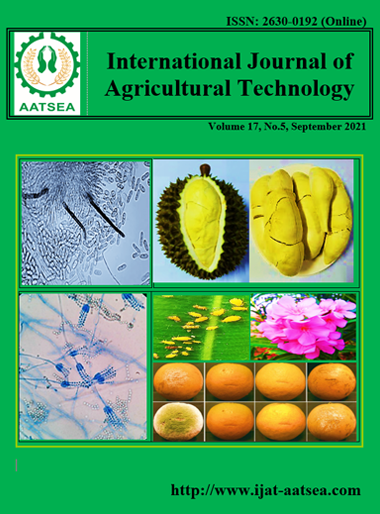Assessment of awareness of broiler chicken welfare in Gaborone, Botswana
Main Article Content
Abstract
Scientific information on broiler chicken welfare in Botswana is scarce. The awareness of poultry welfare in selected commercial broiler farms in Gaborone was assessed. A structured questionnaire was administered to 25 randomly selected farms and through direct observation. Results showed that mainly men (72%) were found actively involved in broiler chicken production. Ninety-six percent of the respondents strongly agreed that animal welfare is an important aspect in commercial poultry production. Furthermore, 64% of the respondents strongly agreed that welfare during transportation was good while 56% of the respondents strongly agreed that overcrowding affects welfare. Additionally, 80% of the respondents strongly agreed that beak trimming affects birds’ welfare, whereas 96% agreed that light affects performance of broiler chickens. Eighty-eight percent of the respondents strongly agreed that pre-slaughter management practices affect performance of birds. All the respondents in this study carried out vaccinations. Three heat sources were used during brooding and these are mbaula, electric heater and infra-red lamp. These results suggested that there is a need to educate broiler farmers on poultry welfare and how it affects the performance of birds
Article Details

This work is licensed under a Creative Commons Attribution-NonCommercial-NoDerivatives 4.0 International License.
References
Abbas, T. E. (2014). Poultry welfare in developed and developing countries. Animal and Veterinary Sciences, 2:1-4. doi: 10.11648/j.avs.20140201.11
Bessei, W. (2006). Welfare of poultry: A review. World Poultry Science Journal, 62:455-466.
Broom, D. M. (1986). Indicators of poor welfare. British Veterinary Journal, 142:524-526.
Buyse, J., Simons, P. C. M., Boshouwers, F. M. G. and Decuypere, E. (2006). Effect of intermittent lighting, light intensity and source of the performance and welfare of broilers. World's Poultry Science Journal, 52:121-130.
Cobb-Vantress Inc. (2008). Brooding fundamentals guide. Retrieved October June 10, 2020, from http://www.cobb-vantress.com/docs/default-source/management-guides/brooding-fundamentals-guide.pdf
Duncan, I. J. H. (1989). The assessment of welfare during the handling and transport of broilers. In: J. M. Faure and A. D. Mills (Eds.), Proceedings of the Third European Symposium on Poultry Welfare. pp. 93-107.
Duncan, I. J. H. and Fraser, D. (1997). Understanding animal welfare in M. C. Appleby and B. O. Hughes B.O., (Eds). Animal welfare. Wallington, UK. Centre for Agriculture and Bioscience International Publishers, pp. 19 -31.
Farm Animal Welfare Council (1979). Updates the five freedoms. Veterinary Record, 13:357.
Farm Animal Welfare Council (2008). Report on the implication of the docking for the welfare of poultry, June 2008. Farm Animal Welfare Council, London, UK. Retrieved from http://www.oznet.ksu.edu/NEreaOffice/animal.htm
Grow, A. G. (1995). Writing guidelines to require disinfection. Revue Scientifique et technique (International Office of Epizootics), 14:469-477.
Knowles, T. G. and Broom, D. M. (1990). The handling and transport of broilers and spent hens. Applied Animal Behaviour Science, 28:75-91.
Leeson, S. and Summers, J. D. (2000). Broiler breeder production. Guelph, Canada: University Books.
Manser, C. E. (1996). Effects of lighting on the welfare of domestic poultry: A review. Animal Welfare, 5:341-360.
Mitchell, M. A. and Kettlwell, P. J. (2009). Welfare of poultry during transport - a review. Poultry Welfare Symposium Cervia, Italy, 18-22 May 2009. Retrieved from https://www.researchgate.net/publication/255627668_Welfare_of_poultry_during_transport_-_A_review
Moreki, J. C., Magapatona, S. and Manyeula, F. (2020). Effect of stocking density on performance of broiler chickens. International Journal of Agriculture and Rural Development, 23:5367-5372.
Morris, T. R. (1967). Light requirement of the fowl. In: T.C. Carter: Environmental control in poultry production. Oliver & Boyd Ltd, Edinburgh and London. pp. 15-39.
Nicol, C. J. and Davies, A. (2012). Poultry welfare in developing countries. Poultry Development Review. Food and Agriculture Organization of the United Nations. Retrieved from www.fao.org/3al720e/al720e00.pdf
Nicol, C. J., Caplen, G., Edgar, P. and Browne W. J. (2009). Associations between welfare indicators and environment choice in laying hens. Animal Behaviour Science Journal, 78:413- 424.
OIE - Terrestrial Animal Health Code - 28/06/2019. Chapter 7.10: Animal Welfare and Broiler Chicken Production Systems.
OIE (World Organization for Animal Health) (2011). Animal welfare in OIE Member Countries and Territories in the SADC Region: Summaries of baseline country assessments.
Rauch, A. and Sharp, J. (2005). Attitudes about animal welfare. Social Responsibility Initiative Department of Human and Community Resource Development. The Ohio state University. Retrieved from http://www.oznet.ksu.edu/NEreaOffice/animal.htm
Renema, R. and Robinson, F. E. (2000). Reproductive implications of full feeding female meat-type poultry parent stocks. Proceedings of the 21st World’s Poultry Congress (Paper S3.3.02). Montreal, Canada: World’s Poultry Science Association.
Ross Breeders (1999). Ross Broiler Management Manual. Ross Breeders, November 1999.
Škrbić, Z., Pavlovski, Z. and Lukić, M. (2009). Stocking density - Factor of production performance, quality and broiler welfare. Biotechnology in Animal Husbandry, 25:359-372.
Tannenbaum, J. (1991). Ethics and animal welfare: The inextricable connection. Journal of the American Veterinary Medical Association, 198:1360-1376.
Watkins, S. (2003). Animal welfare audits: What to expect and how to be prepared. Avian Advice, 5:6-8.
Weeks, C. A. and Nicol, C. J. (2006). Behavioural needs, priorities and preferences of laying hens. World's Poultry Science Journal, 62:297-307.


